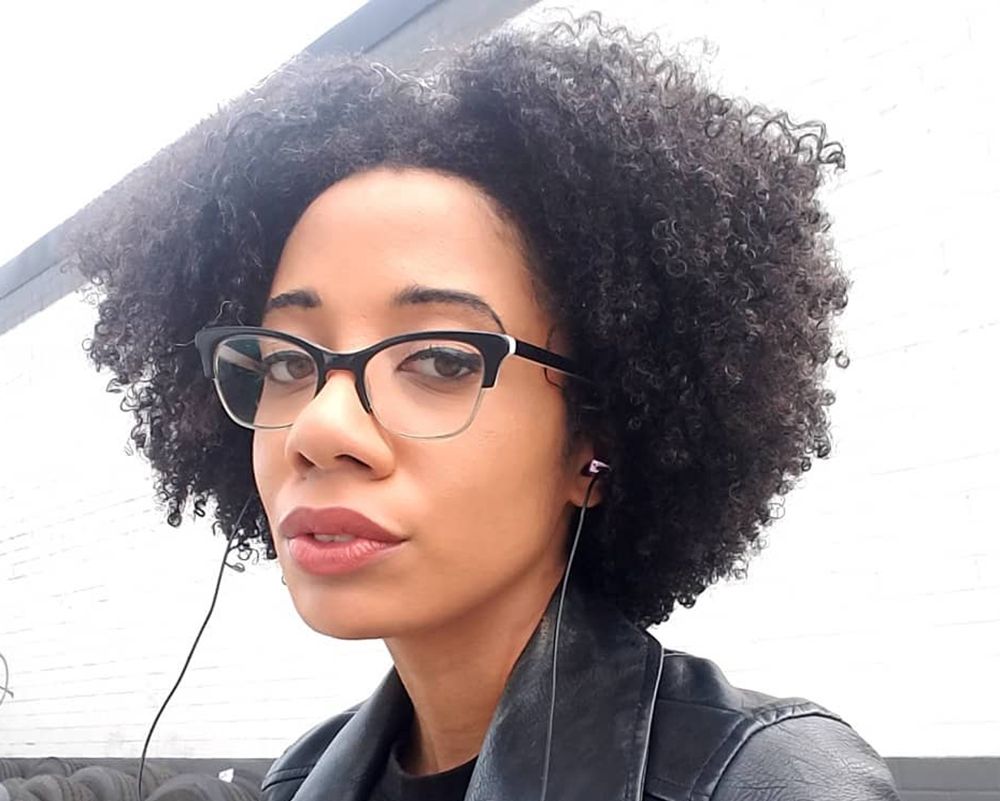Though the hair typing system is controversial, for many naturals identifying your curl pattern can really inform how you look after your hair. It can be difficult to find the right products when you don’t know what your hair type is.
If you have curly hair that has a varied texture and a little less definition, chances are you have 4B hair. Whether you’re new to the typing system or a certified pro when it comes to keeping your curls in check, we’ve got you covered. With the help of hairstylist Charlotte Mesah, trichologist Kari Williams, Ph.D., and curly hair expert Dillan Bawamia, we’ve created the ultimate guide to type 4B hair. Keep reading for more.
Meet the Expert
- Charlotte Mensah is an award-winning hairstylist and author and the founder of the Manketti Oil hair care range.
- Kari Williams, Ph.D., is a trichologist and hairstylist. Her clients include Halle Berry, Chloe Bailey, and Ava DuVernay.
- Dillan Bawamia is a curly hair expert. He is also a salon manager at Textures Salon London.
What Is Type 4B Hair?
According to Mensah, type 4B hair is similar in shape to type 4C hair, with differences in density and coarseness being the only distinctions between the hair types. “4B hair has a less defined pattern of curls and looks more like a Z shape, due to the hair bending at a sharp angle,” Mensah adds. 4B curls are also quite tight, which makes them easy to manipulate.
How Can Type 4B Hair Be Identified?
The key to identifying 4B hair is in the curl pattern. 4B curls will not form a uniform curl or coil, hence the zig-zag pattern. Williams also adds that the 4B curl patterns tend to have sharp angles. Type 4B hair also tends to be quite fluffy looking and dry in texture.
Although these are the main attributes of 4B hair, something to keep in mind is that no two 4B hair routines are going to be identical, as all 4B hair is different. Paying attention to the health and happiness of your hair in accordance with the regime you are using is key. Something else to be mindful of is that people with 4B hair might also have patches of 4A and 4C textures throughout their heads.
How Does Type 4B Hair Differ From Other Hair Types?
According to Williams, the biggest difference between 4B hair and other hair types is the pattern of the curl, which is less defined. Type 4A hair is able to retain moisture quite well and as a result, it doesn’t shrink as much as 4B hair. Type 4A curls are also a lot more defined, while 4B curls are smaller and can be quite coarse in texture. Type 4C hair is said to have the tightest curl pattern of all the curly hair types; however, because the strands of the hair are tight and springy, it is just as prone to shrinkage as 4B hair.
Up to 50-75 percent shrinkage can occur in 4B hair. To get the most out of type 4 curls, a significant amount of moisture, minimal reliance on heat, and regular protective styling are required.
How Should You Care for Type 4B Hair?
Type 4 hair tends to be fragile, so you may find yourself on the lookout for different products and techniques that can breathe new life into your curls. “It’s important to remember that all curls require the following steps: cleansing, conditioning, lubricating, and a reduction in manipulation as much as possible to prevent breakage,” says Williams. In addition to these required steps, there are some simple practices that can be adopted as part of your regime to keep your curls happy and healthy.
Optimize Your Wash Day
Wash day routines are integral to hair health, so it’s important that the right products are used to wash, detangle, and style hair. For 4B hair, Mensah recommends washing hair weekly with a moisturizing shampoo such as the Charlotte Mensah Manketti Oil Shampoo ($31) or Aveda’s Be Curly Shampoo ($27). Both contain extra emollients, which provide a protective barrier that contributes to moisturizing, softening, and smoothing the hair. Emollients also impart gloss and softness to hair and are used in leave-on and rinse-off conditioning formulations. “To get the best out of these moisturizing shampoos, I recommend using a rinse-out conditioner,” says Mensah.
4B hair types might benefit from co-washing, but Williams adds that this technique should not replace the use of your regular shampoo. She recommends utilizing the LOC method for best results. “When it comes to curly hair, I recommend keeping things simple,” she says. “Also, do have a look at the ingredients of any leave-in conditioner you are using. If it contains hydrolyzed proteins, stop using it as excessive usage can cause the hair strands to feel dry and brittle.” Bawamia adds that 4B hair types shouldn’t get too used to co-washing as this method will not cleanse your scalp in the way you expect. “Neglecting to use shampoo as part of your wash day routine can make room for bacteria to grow on your scalp and hair,” he says.
Moisture Is the Name of the Game
4B hair can be prone to dryness, and moisture can help to hydrate hair and reduce breakage. To ensure that your hair is getting the moisture it needs, Mensah recommends giving yourself a hot oil treatment on a monthly basis to seal in moisture, and for day-to-day maintenance moisturizing hair with light cream or oil. “Natural hair soaks up moisture like a sponge, so moisturize, moisturize, moisturize,” she says. One of the reasons why 4B hair lacks moisture is due to the sharp angles making it difficult for sebum to coat the entire fiber. So we guess it’s safe to say that it’s time to make moisture your friend when caring for your type 4 curls (if you haven’t already).
Although moisture is key to looking after 4B hair, these hair types should be mindful of overloading hair with products. “A good leave-in and sealant of your choice are actually more than enough for 4B hair. I would recommend applying products to soaking wet hair for best results,” says Bawamia.
Avoid Silicone
According to Williams, products that contain silicone should be avoided unless a sulfate shampoo is being used to remove buildup from strands. 4B hair types will also need to replenish moisture with a hydrating shampoo if products containing silicone are used as part of their hair care routines. To determine whether you can introduce silicone into your hair care routine, pay attention to how your hair reacts. “Some silicones might work for more tightly coiled patterns like 4B hair because they seal in moisture and add an extra layer of protection to the strands,” Williams says.
Wash Your Hair Less…
Although all 4B hair is different, anyone with this hair type might find it beneficial to wash their hair a little less than they usually would. If you need to shampoo your hair due to oil buildup, scalp discomfort, or a really active lifestyle, Williams recommends using moisturizing shampoos and conditioners. Don’t forget to use a leave-in conditioner after each wash and to follow up with a good oil to seal in moisture.
… and Wash in Sections
Many naturals dread wash day, as giving your hair the TLC it rightfully deserves can be very time-consuming. Since type 4B hair tends to be quite dense and coarse in texture, washing hair in sections might help make wash day a little more bearable. “Washing hair in sections will help get the hair scalp clean, which is important for dense hair types,” says Williams. “Hair density can make it difficult to thoroughly cleanse the hair and scalp and can cause scalp irritation and dry hair in the process.”
Care For Your Protective Styles, Too
For 4B hair types that turn to protective styling, it’s important not to neglect your hair when it has been styled. “I recommend applying a light oil to your scalp once or twice a week when wearing braids or cornrows,” says Mensah. It’s easy to neglect your protected hair while wearing a protective style, but just like your natural hair, your protected hair needs additional moisture. Mensah suggests taking five minutes to pamper your hair before bedtime by adding moisture (if necessary), securing the ends, and covering it at night.
Make Use of Satin Pillowcases
Williams recommends using a satin pillowcase, as they are a “great accessory to introduce into your hair care routine.” But it is important to keep in mind that a satin pillowcase alone will not be able to reverse hair damage. “If your hair is excessively dry or breaking, it’s not because of your pillowcase,” she adds.
What Are Some of the Best Hairstyles and Cuts for 4B Hair?
4B hair is quite versatile so there aren’t really any limits to how it can be manipulated. Williams recommends round halo cuts and angular bobs as well as “enhancing curls with rod sets, twist sets, and braid sets.” When it comes to styling and cutting 4B hair, the most important thing is to do what works for your lifestyle and overall style. For those who take a low-maintenance approach to haircare, Bawamia recommends keeping your hair in twists for a week and wearing them as a twist-out the following week. “This will ensure you’re not messing with your hair too much. Over manipulating 4B hair can actually weaken its ends,” he says.
To ensure that your 4B curls hold on to protective styles, using a gel or curling lotion may help to both clump hair strands together and enhance the curl pattern. This may also be an ideal option for any naturals that love a wash-and-go hairstyle. As far as maintenance for 4B hair goes, Bawamia recommends visiting the salon for a trim every three to four months.
The Best Products for 4B Hair
According to Williams, the best products for 4B hair are infused with moisturizing ingredients and natural oils. Here are some of the products our experts have recommended for 4B hair:
:max_bytes(150000):strip_icc()/CharlotteMensahShampoo24.00-923ee74d039b4c8bb031134448175abf.jpg)
:max_bytes(150000):strip_icc()/Keracare-5c0949f4ebbf4166af574881f919fc1b.jpeg)
:max_bytes(150000):strip_icc()/Carols-Daughter-Hair-Milk-Original-Leave-In-Moisturizer-1copy-30f3a8077382442e9b9c782f03eba423.jpg)
:max_bytes(150000):strip_icc()/Deva_GS_CurlBond_Mask_8oz_NEWcopy-a09810d1f9804773b8859407760d7031.jpg)
:max_bytes(150000):strip_icc()/HolyCurls_04Gelcopy-2aeb35b5d2eb46f19842adc7f226e859.jpg)
:max_bytes(150000):strip_icc()/LavaCap-BlackOnyx_3_2048xcopy-8db46eb3f50b47dc913ec4addaa31005.jpg)
:max_bytes(150000):strip_icc()/LavaCap-BlackOnyx_3_2048xcopy-8db46eb3f50b47dc913ec4addaa31005.jpg)
Black Onyx
Lava Cap and Palm Pebble
$43.00
Lava Cap was created for the sole purpose of saying goodbye to dry and frizzy hair. Each cap boosts hair hydration with gentle heat as the hair is being deep conditioned. In addition to its flaxseed filling, the cap is also microwave-friendly and super easy to use. You’ll have beautifully soft hair in no time.
How to Treat High Porosity Hair










